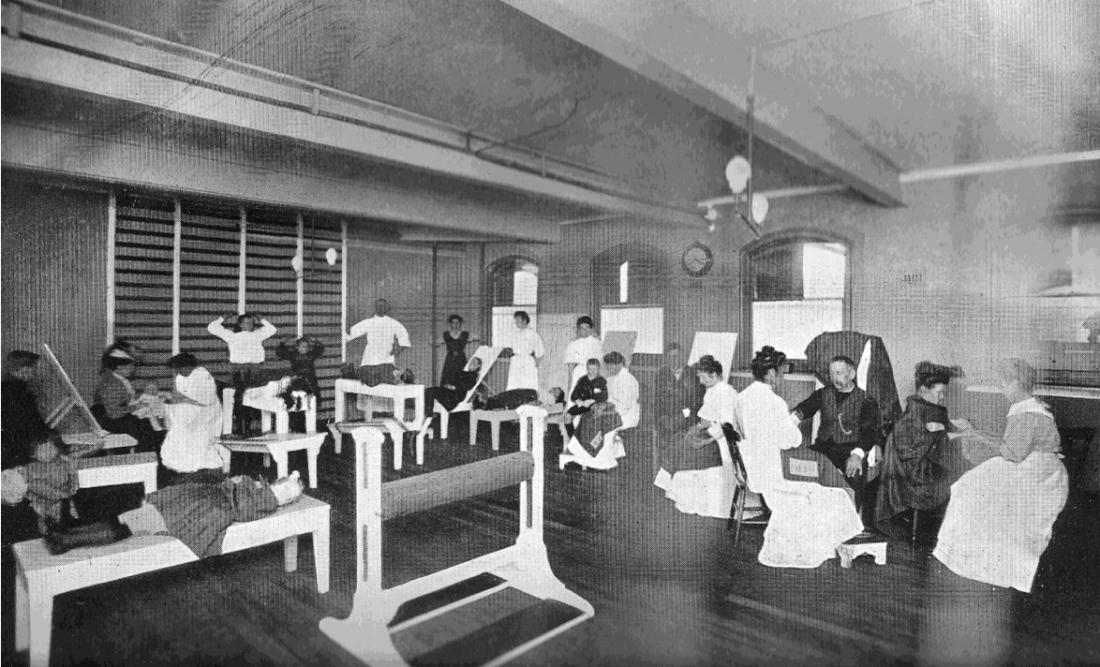In 1889 lectures and exams on the subject of ‘the massage battery’ were given to trainee third year nurses, who initially carried out practical work in massage and electricity in the Royal Prince Alfred (RPA) wards and outpatients department. These practices reflected the overseas work of Swedish practitioner Per Henrik Ling, who in 1813 had founded the Gymnastic Central Institute at Stockholm where he pioneered a series of gymnastic movements to help relieve chronic pain.
RPA chairman Professor Thomas Peter Anderson Stuart had kept abreast of these developments during his overseas travels. On his return to Sydney in 1902, he spoke at a RPA board meeting about physical culture for children and electrical treatment in massage. He explained that Australia was being left behind in many areas, with departments of medical gymnastics already well evolved in hospitals in America and Europe. Anderson Stuart’s interest in physical deformities and his considerable influence led to the hospital taking steps to introduce a gymnastic department.
The hospital directors looked to a Sydney exponent on medical gymnastics, physician Dr Reuter Roth, who advertised his practice and teaching of medical gymnastics and massage in the Australasian Medical Gazette in the 1890s. They agreed that a memorandum based on his advice be submitted to the board, which led to Roth planning the department of medical gymnastics at RPA. It was the first department of medical gymnastics to be established in Australia. A masseur was appointed in 1902 and a massage service introduced.
In 1906 it was known as the ‘Department of Massage, Medical Gymnastics and Electricity.’ Roth was the only candidate for the role of director and was appointed honorary medical officer. Qualified and experienced massage therapists were employed. Three honorary masseurs and ten honorary masseuses were appointed to positions of part-time work for one year, attending twice a week. These practitioners were differentiated by their dress: men wore long white coats, and women wore ankle-length washing dresses with long sleeves and Peter Pan collars, white aprons and buckled belt, black shoes and stockings.
The Hospital Gazette described the medical gymnastics branch as:
interesting and picturesque”, with “various queer-looking appliances, designed by Dr Roth for the treatment of weak or twisted backs, legs, arms etc., and upon which patients pass through a sort of physical culture course.”
Roth was reported as introducing for the first time in Australasia the Swedish treatment method of medical gymnastics but on a much larger scale.
In late 1907 the new ‘Medical Gymnastics Department’ was opened officially, and became the New South Wales state centre for instruction in what is now known as ‘physiotherapy.’ It was the first physiotherapy training school in the state and was operated by both RPA and Royal North Shore hospitals.
The Hospital Gazette reported on the department’s striking popularity in the month of its official opening, claiming that it had:
developed to quite an unexpected degree, and is now one of the most sought after branches of hospital work. On the afternoons on which the department is open, the vestibule is crowded with patients, waiting their turn to be massaged or to undergo the varieties of treatment which are ordered by the medical officers.”
As a result there was an increase made to the number of honorary massage staff, with several extra women employed to meet the demand for treatment.

The RPA Medical Gymnastics Department Staff – 1913.
By the end of World War One, surgeons who had gained enormous experience in the knowledge and treatment of orthopaedic cases during the war, returned to Australia keen to create an orthopaedic department in connection with the medical gymnastics service at RPA. They believed that ‘after-treatment’ such as massage, exercises, electricity or various types of baths would greatly benefit patients in cases where surgical operation was not recommended.
By 1920 the government’s Repatriation Department regarded RPA its chief hospital, and the advances of the Medical Gymnastics Department were highlighted in the Hospital Gazette:
…during the last three or four years no department of the hospital has shown such increase in organisation and equipment as the department of massage, medical gymnastics and electricity.”
By this time it was housed in almost the whole of the basement of the Albert Pavilion, divided into separate spaces. These contained consultation, waiting and electrical rooms, rooms for hot air equipment, a gymnasium, and a whirlpool bath room. Specific treatment rooms for women, men and children were created. Outpatients as well as inpatients were treated. The standard of medical work was kept to a high standard because of the presence of students, and it was seen as a highly progressive department. In 1922 a splint mechanic was appointed for the first time.
During the 1930’s poliomyelitis epidemics meant that RPA needed to focus on the needs of patients with musculoskeletal disorders, and this helped to elevate the role of the masseurs and masseuses. And around 1940 (exact date unknown) the ‘Department of Massage, Medical Gymnastics and Electricity’ updated its name to the more modern sounding ‘Physiotherapy Department’.
References
Witton, V. 2015. Medical Gymnastics, Massage and Electricity: How physiotherapy came to RPA. RPA Heritage News, 6(2), 1-3. Accessed online at https://www.slhd.nsw.gov.au/rpa/museum/news/2015%20October.pdf

